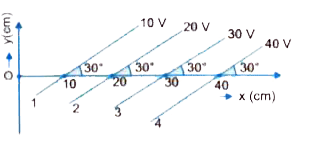Electric lines of force always leave an equipotential surface
at any angle to the surface
parallel to the surface
perpendicular to the surface
Parallel or perpendicular to the surface
The correct Answer is:C
Topper's Solved these Questions
- ELECTRIC CHARGES AND FIELDSBOOK - AAKASH SERIESCHAPTER - ELECTRIC CHARGES AND FIELDSEXERCISE - Exercise-II
56 Videos
- ELECTRIC CHARGES AND FIELDSBOOK - AAKASH SERIESCHAPTER - ELECTRIC CHARGES AND FIELDSEXERCISE - Practice Exercise
57 Videos
- ELECTRIC CHARGES AND FIELDSBOOK - AAKASH SERIESCHAPTER - ELECTRIC CHARGES AND FIELDSEXERCISE - Assess Your Self
13 Videos
- DUAL NATURE OF RADIATION AND MATTERBOOK - AAKASH SERIESCHAPTER - DUAL NATURE OF RADIATION AND MATTEREXERCISE - PRACTICE EXERCISEX
44 Videos
- ELECTRIC FIELD AND POTENTIALBOOK - AAKASH SERIESCHAPTER - ELECTRIC FIELD AND POTENTIALEXERCISE - PROBLEMS (LEVEL-II)
32 Videos
Similar Questions
Knowledge Check
Consider the following statements about equipotential surfaces and select the correct ones.
I. No work is required to be done to move a test charge between any two points on an equipotential surface.
II. Electric lines of force at the equipotential surfaces are mutually perpendicular to each other.ABoth I and II are correctBI is correct and II is IncorrectCI is incorrect and II Is correctDI and II both are IncorrectThe angle between the equipotential surface and the electric field (or line of force) at any point on the equipotential surface is
A90∘ alwaysB0∘ alwaysC0∘ to 90∘D0∘ to 180∘The electric field lines coming out of an equipotential surface are
Aperpendicular to the surfaceBparallel to the surfaceCin all directionsDzero
Assertion(A): Electric field is always normal to equipotential surfaces and along the direction of decreasing order of potential
Reason(R): Negative gradient of electric potential is electric field.
View SolutionOn the basis of your understanding of the following paragraph and the related studied concepts.
An equipotential surface is a surface with a constant value of electric potential at all points on the surface. The component of electric field parallel to an equipotential surface is zero, as the potential does not change in this direction. Thus, the electric field is perpendicular to the equipotential surface at each point of the surface. Further, say the direction of electric field electrical potential gradually fall with distance.
Four equipotential surfaces are shown in the adjoining figure. Find the magnitude and direaction of the electric field.

View SolutionOn the basis of your understanding of the following paragraph and the related studied concepts.
An equipotential surface is a surface with a constant value of electric potential at all points on the surface. The component of electric field parallel to an equipotential surface is zero, as the potential does not change in this direction. Thus, the electric field is perpendicular to the equipotential surface at each point of the surface. Further, say the direction of electric field electrical potential gradually fall with distance.
Draw equipotential surfaces around an isolated positive point charge + q. Mark direction of electric field →E also.
View SolutionSTATEMENT -1 : the surface of a charged conductior is always equipotential .
STATEMENT -2 : Electic field lines are always perpendicular to the equipotential surface.
View SolutionLines of force cut equipotential surface
View Solution
